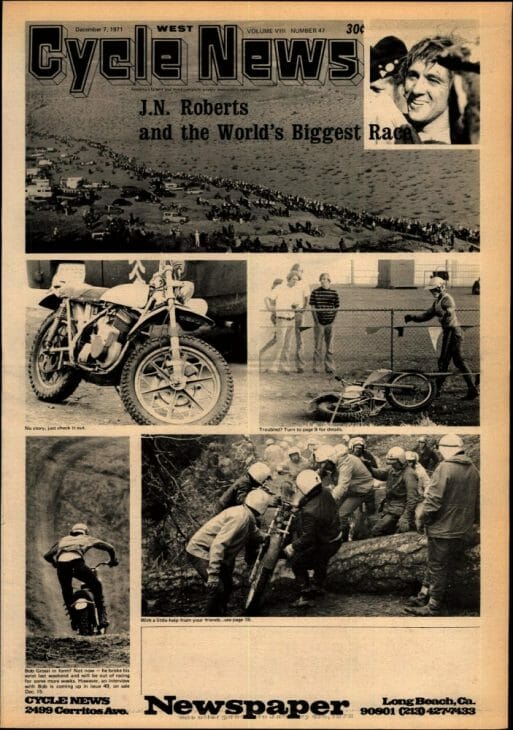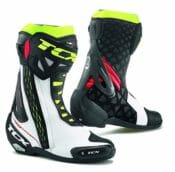
It seemed you couldn’t thumb through an issue of Cycle News in the 1970s without seeing a headline featuring J.N. Roberts. Roberts was so dominant in in desert motorcycle racing events that he became known as that era’s King of the Desert.
Just check out on YouTube the part of the documentary movie On Any Sunday that features Roberts flying across the desert on his beloved Husqvarna. Roberts and his Husky are in perfect harmony as he dances the bike across the high desert of Southern California avoiding rocks, ruts and big clumps of Greasewood bushes.
Roberts won just about all the major desert cross-country races of the 1960s and ‘70s including Barstow to Vegas four consecutive times (1968 to 1971). He also won the Mint 400 three times and the Baja 500 and the Baja 1000 twice each. He teamed with Malcolm Smith to win the motorcycle division in the 1967 Mexican 1000, later to be known as the Baja 1000. Roberts also represented the United States at the 1971 and 1972 International Six Days Trial.
You would think a rider who attained Roberts’ level of skill on a motorcycle would have started as a kid, but that wasn’t the case for J.N. (which stands for James Nelson). Roberts grew up in Southern Indiana. “We were right on the border,” he said. “Step a foot in the river and you were in Kentucky.”
He only occasionally had the opportunity to ride a motorcycle around the back of a BSA motorcycle shop in Evansville where his cousin worked.
“We’d go down to the shop and they had a little track in the back and we’d beat around on a little 200, no helmet and that kind of thing,” Roberts explained. “Back in those days nobody had any money for one thing. We were poor. Plus, there were no dirt bikes really. You had to buy something and convert it.”
It wasn’t until Roberts came out of the Marines after four years and moved to California, that he began riding motorcycles on a regular basis.
It was an unusual path to racing.
“I got a ticket,” Roberts grins when asked how he got into racing. “I already had the idea I wanted to ride in the dirt and I had a Honda 250 Scrambler and had taken the lights off it to make it better to ride in the dirt. I got a ticket and hauled into court and I had to promise the judge I wouldn’t ride the bike on the street anymore and I didn’t. I don’t think I ever rode on the street again until I got in the movie business and had to ride a Harley from point A to point B or something.”
Roberts began riding at a gravel pit they called the Branford Wash, where he met Bob Harris and Tom Ryder who were both desert racers. They talked Roberts into racing in his first event, a popular Southern California off-road race called the Moose Run in February of 1965. “I got lost and all screwed up,” Roberts said of his performance in his first event. “But I had fun and it was exciting.”
Between desert races Roberts honed his skills doing scrambles that were held all across Southern California. “You didn’t have to go very far to find a race in those days,” Roberts explained. “Then I turned my little 250 Scrambler into a 350, lightened it up a little bit and started doing real good, beating a lot of 500s in the Open class.”
Roberts raced his Honda with good success until Husqvarna came along in ‘66. He bought one from a dealership in Burbank. “They gave me a break on it, but at that time I think they were about 600 dollars,” Roberts remembers. “I got on the Husky and started winning right away. Next thing I know Edison (Dye) got ahold of me and gave me a new bike.”
With backing from Husqvarna, Roberts became one of the elite desert riders in the country. His training methods were definitely old school.
“I got into the movie business in ’65 building sets,” he explains. “After working all day, I’d get in my truck and drive home with the windows up and just sweat. That was my training until I got home to ride my bike. We didn’t have all the weights and bicycle training that the guys do today. I just rode my bike a lot.
“I knew when I went to the desert I was in shape and even if I didn’t get a real good start, because there were a lot of guys that were a lot quicker starters than me, I knew I’d eventually get ‘em. I’d usually get to the smoke bomb maybe somewhere from number five to 10, something like that. I think maybe a couple of times I got to the smoke bomb first, but not very often.”
Roberts was winning in the desert at a time when the sport was at an absolute peak. Check out the numbers Roberts talks about!
“The biggest race was always Barstow to Vegas,” he said. “The first time I raced that I think there were 2000 entries. The last time I raced it there were something like 4000 entries! But even with that many riders, just like to today in motocross and Supercross, there would usually only be four or five riders who could win the race and those were the guys you raced against.”
At his peak in the late ‘60s and early ‘70s Roberts was just about unbeatable in the desert. Tracy Husqvarna, the Burbank dealership which sponsored him, kept track of his wins. “I remember one year he had it up there that I’d won either 22 or 26 races,” Roberts recalls.
Roberts raced Husky professionally nearly his entire career. Only briefly did he park the bike.
“Once Edison thought he was paying me too much or something and didn’t want to renew my contract,” Roberts smiles. “I got on a Weslake BSA and won right away. When Edison saw that he wrote my contract back up.”
Roberts never got rich from desert racing, but was probably one of the few who made decent money at the sport.
“When I won a desert race Edison would pay me 250 dollars,” Roberts said. “When I won one of the big races I’d get my prize money, plus 500 dollars. I was making $3.27 an hour at a union job, so that was big money back in those days!”
Surprisingly in all of Roberts’ racing career he stayed mostly injury free, never suffering much more than a broken collarbone.
Eventually Roberts began working as a Hollywood stuntman and was traveling so much that he gradually backed away from his heavy racing schedule. But he never quit and still races veteran races to this day.
Roberts now owns a cattle ranch in Montana, where he has a 20-mile riding loop. He’s an inductee of Motorcycle Hall of Fame and is also in the Off-Road Motorsports Hall of Fame.
Roberts stood atop the field in desert racing during a golden era and will forever be remembered as one of the all-time greats of that form of motorcycle racing.
